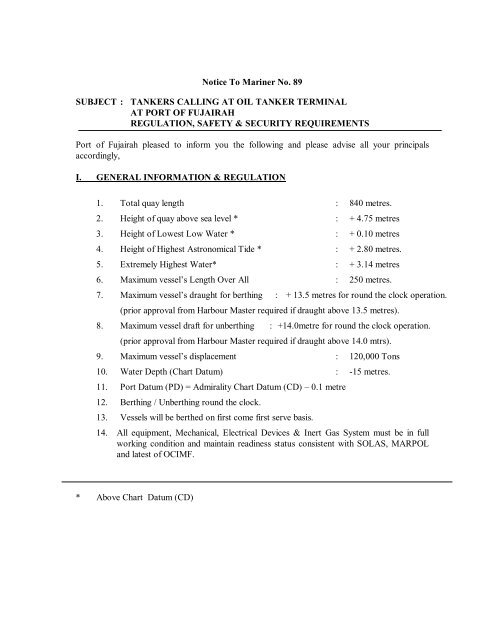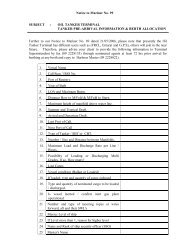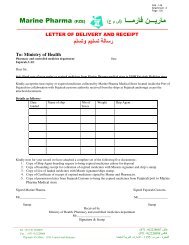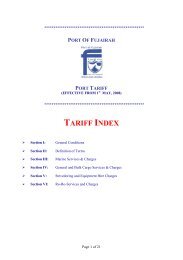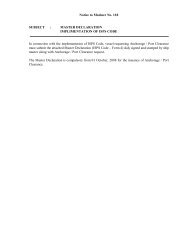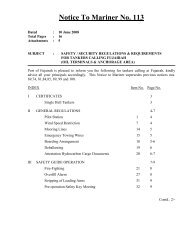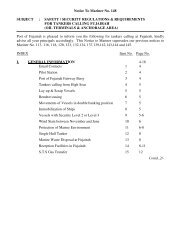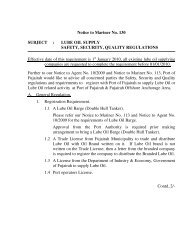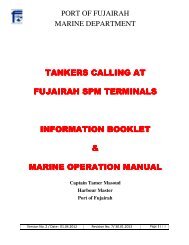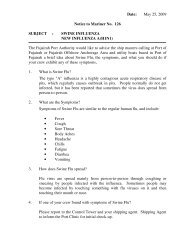Notice To Mariner No. 89 SUBJECT : TANKERS ... - Port Of Fujairah
Notice To Mariner No. 89 SUBJECT : TANKERS ... - Port Of Fujairah
Notice To Mariner No. 89 SUBJECT : TANKERS ... - Port Of Fujairah
Create successful ePaper yourself
Turn your PDF publications into a flip-book with our unique Google optimized e-Paper software.
<strong><strong>No</strong>tice</strong> <strong>To</strong> <strong>Mariner</strong> <strong>No</strong>. <strong>89</strong><strong>SUBJECT</strong> : <strong>TANKERS</strong> CALLING AT OIL TANKER TERMINALAT PORT OF FUJAIRAHREGULATION, SAFETY & SECURITY REQUIREMENTS<strong>Port</strong> of <strong>Fujairah</strong> pleased to inform you the following and please advise all your principalsaccordingly,I. GENERAL INFORMATION & REGULATION1. <strong>To</strong>tal quay length : 840 metres.2. Height of quay above sea level * : + 4.75 metres3. Height of Lowest Low Water * : + 0.10 metres4. Height of Highest Astronomical Tide * : + 2.80 metres.5. Extremely Highest Water* : + 3.14 metres6. Maximum vessel’s Length Over All : 250 metres.7. Maximum vessel’s draught for berthing : + 13.5 metres for round the clock operation.(prior approval from Harbour Master required if draught above 13.5 metres).8. Maximum vessel draft for unberthing : +14.0metre for round the clock operation.(prior approval from Harbour Master required if draught above 14.0 mtrs).9. Maximum vessel’s displacement : 120,000 <strong>To</strong>ns10. Water Depth (Chart Datum) : -15 metres.11. <strong>Port</strong> Datum (PD) = Admirality Chart Datum (CD) – 0.1 metre12. Berthing / Unberthing round the clock.13. Vessels will be berthed on first come first serve basis.14. All equipment, Mechanical, Electrical Devices & Inert Gas System must be in fullworking condition and maintain readiness status consistent with SOLAS, MARPOLand latest of OCIMF.* Above Chart Datum (CD)
215. All mooring winches must be fully operational and supplied with maximum requiredpower.16. Maximum allowed trim is 0.015 x L.O.A17. In case of Pollution or Fire, immediately inform the <strong>Port</strong> Control.18. Wind Speed restriction for Marine Loading Arm (B0030).• Suspend operation : 25 knots• Stop operation : 40 knots• Parked position : 80 knots19. Maximum operational wind speed is 30 knots.20. Immobilising, Hot work, Tank cleaning and tank washing are not allowed at OilTerminal.21. Maintenance not permitted at O.T.T berths.22. Crew change is allowed at O.T.T Berths.23. Fresh water supply available through pipeline at the quay.24. De-slopping by onshore pipeline not available at the Terminal.25. Bunker barge / Slop barge / utility boats are not allowed alongside while cargooperation.26. If there any protrusion on ship’s hull, then ship’s agent should arrange pneumaticfenders.27. Mooring lines.27.1 Ropes or wires acceptable.27.2 Wires should be used for mooring if available.27.3 If vessel uses ropes and wires at the same time, mix up not allowed for themoorings leading in the same direction of head, stern, breast and spring.27.4 All mooring lines should be in good condition with same tension.28. Product QualityA) Oil Tanker Berths are equipped with pipe racks, bridges, Marine Loading Armsand manifold. The users have to arrange pipes from tank farms to quaymanifold (up to MLA).B) After each operation (Loading or discharging) the stripping of Loading Armscan be done by the following options,i) <strong>To</strong> Tanker.ii)iii<strong>To</strong> Quay sump tank.Marine Loading Arm.First part : Outboard arm assembly to tanker.Second part :Riser and inboard arm assembly to quay sump tankor company line.
29. Emergency <strong>To</strong>wing Wire3Two Emergency <strong>To</strong>wing wires-one forward and aft. the forecastle on the weatherdeck and aft., length 50 m – 55m, diameter 28 mm. The wires must be the typerecommended for good quality mooring wires each wire must have two eyes. Oneeye goes over the ship’s bollard with extra two turns to take the tension for a safe andsecured towing. The other eye must be maintained one metre (1 metre) above thewaterline at any freeboard.Please find attached the sketchIIFACILITIES PROVIDED BY PORT OF FUJAIRAH• 840 meter continuous quay.• Depth – 15 meter (Chart Datum)• Shared pipe rack structures parallel to the berths.• Shared pipe bridge structures to the loading platforms on the berths.• 20 Loading arms and control systems at berths (8 x 16” + 12 x 12”).• 3 Control rooms & installations at berths.• Power requirements for loading facilities at berths.• Fire protection for the berths.• Foundation and civil works for the above loading installations.• Quick release Hooks (control for releasing all or individual hook from Control Room).• Mast Lights.• Fenders (Cone Fenders – Fentek (SCN 1050), copy attached.IIIBERTH CONSTRUCTION & DESIGN CRITERIA.* Oil Tanker Terminal in <strong>Port</strong> of <strong>Fujairah</strong> is designed to accommodate following sizesof vessels and MLA,Berth <strong>No</strong>.Length x DepthMax. L.O.A xMax DraughtMax. Displacement(in Meter) (in Meter) (in Meter)M.L.AOTB 1 240 x 15 180 x 13.5 54,000 4 x 12”OTB 2 (West) 150 x 15 130 x 13.5 25,000 2x 12”OTB 2 300 x 15 250 x 13.5 120,000 4 x 16”OTB 2 (East) 150 x 15 130 x 13.5 25,000 2x 12”OTB 3 (West) 150 x 15 130 x 13. 5 25,000 2 x 12”OTB 3 300 x 15 250 x 13.5 120,000 4 x 16”OTB 3 (East) 150 x 15 130 x 13.5 25,.000 2 x 12”
4IVCERTIFICATESTankers calling at <strong>Port</strong> Terminals or F.O.A.A must comply with MARPOL and SOLASand vessel’s all documents and following certificates must valid and available onboard.a) Load Line Certificateb) Cargo Ship Safety Construction Certificate.c) Cargo Ship Safety Equipment Certificate.d) Cargo Ship Safety Radio Certificate.e) Civil Liability Certificate issued from flag state (issued in accordance withprovisions of International Convention on civil Liability for oil pollution damage1992).f) The International Oil Pollution Prevention (I.O.P.P) Certificate.g) Ship’s Register Certificate.h) Classification Certificate (Hull & Machinery).i) De-ratting Certificate.j) ISM Certificate.k) Oil Record Bookl) Shipboard Oil Pollution Emergency Plan.m) International Ship Security Certificate.Single Hull Tankers1. Single Hull Tankers of more than 25 years of age are not allowed forHydrocarbon operation.2. CAS certificate and Flag State Permission required for Single Hull Tankers ofage between 15 and 25 years.V) NOTIFICATION OF SHIP’S INFORMATION & CONFIRMATION1. Following ETA messages and information required to be forwarded to <strong>Port</strong> Controlby Ship’s Agent.1.1. 72 hours <strong><strong>No</strong>tice</strong> and advise the ETA to Pilot Station (refer our <strong><strong>No</strong>tice</strong> to<strong>Mariner</strong> <strong>No</strong>. 69 date 21/08/2002).1.2. 48 hours <strong><strong>No</strong>tice</strong> updating E.T.A & arrival draught.1.3. 24 hours <strong><strong>No</strong>tice</strong> updating E.T.A & arrival draught.2. The following details should be sent to Harbour Master’s office prior vessel’s arrivalevery time,2.1 Permission to Enter – ISPS Form <strong>No</strong>.1 (amended on 29/03/2006) (copyattached).2.2 Arrival & Departure draught.
2.3 Arrival displacement.2.4 Ballasting and de-ballasting arrangements, specify if SBT.2.5 Number, size and distance between manifold connections.2.6 Maximum load / discharge rate.52.7 Whether simultaneous loading or discharging possible, if more than one grade.2.8 Previous cargo onboard.2.9 Onboard cargo details if any.2.10 <strong>No</strong>minated cargo for loading, quantity and stowage plan.3. Inert Gas System should be operational if applicable and tanks should be inerted toless than 8% of Oxygen by volume. Tankers not fitted with I.G system as perSOLAS chapter II-2 Regulation 60 and carrying oil other than crude oil of flashpoint60 0 C or above can be exempted.4. Confirm the following prior arrival to <strong>Fujairah</strong>,4.1 Tanker free from leakage and all cargo systems are fully operational.4.2 Inert Gas system is operational and tanks are inerted to less than 8% of oxygenby volume.4.3 Stress calculation for cargo and ballasting made and within recommended thesafety limits.4.4 All navigation, mooring, lighting equipment and engines fully operational.4.5 Pilot ladder and equipment comply with SOLAS standard.4.6 Pump room adequately ventilated and illuminated.4.7 Mooring communication system is operational.4.8 Deck lighting is fully operational.4.9 Propeller is fully submerged (maximum as possible).4.10 All certificates as mentioned earlier as per Item <strong>No</strong>. IV are valid and theiroriginals available onboard.4.11 Manifold drip dry clean and no trace of oil4.12 All scupper plugs on deck are closed.4.13 All stores and Accommodation external doors are closed.4.14 All vents adjusted to exclude cargo vapour.4.15 Air conditioner in recycle mode.
4.16 Pump room fan running.4.17 Welding pump rigged properly, ready for instant operation.64.18 Fire fighting equipment ready at the operation manifold, this include ,A- Dry Powder fire extinguisherB- Two fire hoses ready at fwd. and aft. of the manifold.C- Fire plan with updated crew list.4.19 Anti pollution equipment ready at the manifold.4.20 Pressure gauge fitted at both manifold.4.21 Pressure Vacuum valves in good working condition.4.22 All cargo and ballast tanks’ covers are closed.4.23 Readiness of International Shore Fire Connection (ISFC).4.24 Unused cargo and bunker connections secured with blank flanges fully bolted.4.25 All personal on deck wearing the proper protective equipment.5) Confirm the following whilst moored at <strong>Port</strong> of <strong>Fujairah</strong> Oil Terminal5.1 A responsible deck officer man the bridge.5.2 A responsible engineer man the engine control position.5.3 A responsible officer man the cargo control room.5.4 A deck watch maintains during cargo operation at the port or starboard sidemanifold and maintain communication with the bridge and cargo control room.5.5 Will inform <strong>Port</strong> Control immediately, if the tanker has oil pollution or fire.5.6 Two emergency towing wires forward and aft. equipped to be kept ready asper the attached sketch.VIBOARDING ARRANGEMENTSa) SAFE EMBARKATION AND DISEMBARKATION OF THE PILOT:The master of ship navigating in the port or approaches, shall afford such suitable"Weather lee" and speed reductions as dictated by the practice of good seamanship inorder to provide a safe embarkation or disembarkation operation.b) SUPERVISION OF PILOT LADDERS:The rigging of pilot ladders for the embarkation of pilots shall be supervised by aresponsible ship's officer, and shall be so effected that the ladder is well clear of anyoverboard discharge and that each step of the ladder rests firmly against the side ofthe ship.c) PILOT LADDER :A clean and efficient pilot ladder fitted with spreaders and manropes shall be madeavailable for the pilot to embark or disembark. At night the ladder need to beilluminated with efficient and safe light.
7d) ACCOMMODATION LADDER AND PILOT LADDER (COMBINATION):Whenever, as in the case of large vessels, the height of the deck above the waterexceeds 30ft. (9.0 metres) the accommodation ladder shall also be used inconjunction with the pilot ladder and shall be lowered to above 22 ft. (7.0 metres)above the water with the pilot ladder immediately adjacent to the bottom of theaccommodation ladder.e) MECHANICAL HOIST:A mechanical hoist of an approved pattern shall be considered an acceptablealternative to a conventional pilot ladder to be used in conjunction with theaccommodation ladder.NOTE:Mechanical hoist whose operation relies upon a single wire are not of approvedpattern under these rules.VII- DEBALLASTINGIf vessel is Segregated Ballast Tanker (SBT) of the Double Skin Type and all ballast watercontained in the ballast tanks are totally segregated from the cargo tanks, this includes thevents and pipeline, testing inspection before deballasting not applicable.If deballasting required while loading operation, permission can be obtained with thefollowing terms,’1 Deballasting must be in daylight under inspection, testing and monitoring of anapproved petroleum inspector from Testing Services or Oil Laborartory, company.2. The Chemist Surveyor must board the vessel on arrival prior berthing for samplingand testing the ballast tanks and double bottom tanks containing clean ballast water.The analysis & results must be informed to the Control <strong>To</strong>wer by fax and V.H. F.The ballast water must be less than the specified 10 ppm oil content, then onlythe pilot can board the vessel for berthing.3. After berthing, the vessel can start deballasting (in daylight only) under theobservation of Chemist Surveyor. Every hour he must take the samples and thissamples to be tested until completion of the discharge clean ballast water.4. If the surveyor observed any oil content while deballasting, discharging must bestopped immediately and inform <strong>Port</strong> Control through V.H.F radio, Channel 8 & 16.5. Final survey report must be submitted within 24 hours to Harbour Master’s office.VIII SECURITYA- OIL TANKER TERMINAL GATE – ENTRY REGULATION1. All visitors must report to security office before entering.2. <strong>No</strong> unauthorized vehicles at Oil Tanker Terminal.3. <strong>No</strong> pedestrian at Oil Tanker Terminal.4. Visitors to use <strong>Port</strong> vehicles only.5. Visitors to wear helmet and high visibility jacket.6. <strong>No</strong> work permits without pre-approval.
87. Visitors to take care of high voltage inside.8. Speed limit 25 Km for authorized vehicles.9. Visitors to follow fire-fighting instructions if applicable.10. All types of Cameras are prohibited.11. Use of mobile phone is strictly restricted inside terminal.B- VESSEL’S CREW INSTRUCTIONVessel’s crew will be permitted to go ashore according to following Regulation,1. Ship’s agent should submit crew list to security office at O.T.T gate, if crewwould like to visit duty free shop inside <strong>Port</strong>.2. Each person from ship’s crew must carry proper ID card and submit it tosecurity office prior leaving and collect it while enters.3. Safety and security regulation mentioned earlier are to be followed.4. Any crew member wants to go outside the terminal, transportation will beprovided by ship’s agent.5. Follow safety signs or instructions inside the terminal.IXMARINE CHARGESAll tankers loading or discharging hydrocarbon or liquid products in bulk at <strong>Port</strong> of<strong>Fujairah</strong> Oil Tanker Terminal and Main Quay, the charges will be as follows,1. Marine charges for tankers up to 2000 N.RT will be Dhs. 3,000 per call (berthing andunberthing).2. Marine Charges for tankers above 2000 N.R.T will be Dhs. 0.75 per N.R.T. permovement (berthing or unberthing)3. Marine Charges for bunker barges up to 5000 N.R.T will be Dhs. 3,000 per call(berthing and unberthing). This is applicable only to the bunker barges based in<strong>Fujairah</strong>, owned or operated by a Bunkering company based in <strong>Fujairah</strong> with validbunkering License issued by the Government of <strong>Fujairah</strong>.4. The Marine Charge include service of Pilot, Pilot Boat, Tugs, Mooring Gang &Mooing Boats for berthing and unberthing.5 Above charges will be double for vessels without power or with defective steering.6 All Marine Charges will be subject to 100 % surcharge on Fridays and PublicHolidays.7. Garbage Skips are compulsory and are supplied by <strong>Port</strong> Authority at daily rate pership of Dhs. 100/-.8- <strong>Port</strong> Handling Charges.All quantities of loading or discharging hydrocarbon or liquid product in bulk at OilTanker Terminal, <strong>Port</strong> Handling charges will be @ Dhs. 1/- per <strong>To</strong>n for the time beingtill further notice. These temporary measures are subject to review and adjustments incourse of time. Therefore, copy from the Bill of Lading or Quantity Certificate isrequired.


